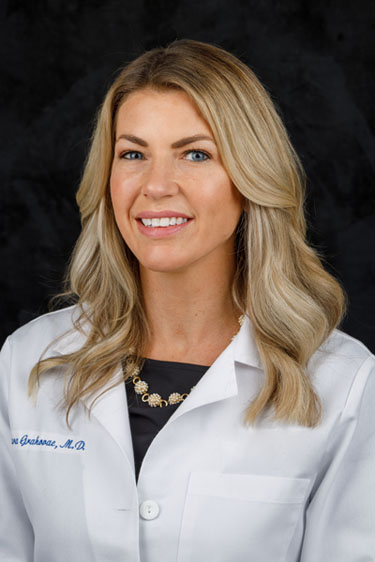Breast Cancer Stages: What They Can Tell You About Your Diagnosis
November 15, 2022Categories: Breast Cancer

Any cancer diagnosis can feel overwhelming. A breast cancer diagnosis is no different. It comes with a lot of information that can be difficult to decipher but that, nonetheless, helps guide treatment decisions. If you’ve been in an oncologist’s office and heard “breast cancer stage,” “grade” and “TNM status,” we help explain what those terms mean and how they relate to your diagnosis.
How Breast Cancer Gets Diagnosed
The path to diagnosis begins when your health care provider detects a lump or other abnormality during a physical exam or sees something concerning on a screening mammogram. They may order imaging, such as a diagnostic mammogram, a breast ultrasound or a breast MRI, to determine if the abnormality is cancerous or benign (noncancerous).
Read More: A Guide to Benign Breast Conditions
Those tests may reveal more concerning signs. To confirm a breast cancer diagnosis, your provider will recommend a breast biopsy, in which a sample of breast tissue is removed and analyzed for cancer cells. Breast biopsies are the most definitive tool for diagnosing breast cancer.
“Depending on what your provider sees on your screening mammogram, you may be recommended for additional imaging and/or a biopsy,” says Dr. Tara Grahovac, a board-certified, fellowship-trained breast surgeon with the Beaufort Memorial Breast Care & Surgery Program. “We review your mammogram and biopsy results and recommend the next best step so we can get the answers we need to proceed.”
Learning Your Breast Cancer Stage
Once cancer has been diagnosed, medical teams use cancer staging to determine how advanced the disease is, which breast cancer treatment is right for you and what your prognosis (chance of recovery) may look like. There are two primary forms of staging:
- Clinical staging, which is based on imaging or biopsy results
- Pathologic staging, which uses pathology reports and lab test results from tissues and lymph nodes removed during surgery
Pathologic staging relies, to some degree, on the TNM system, which describes the size and location of a tumor, whether it has spread to the lymph nodes and if it has metastasized (spread to other parts of the body).
- T represents the size of the primary tumor. TX indicates a tumor cannot be measured. T0 means a tumor can’t be found. Tis means abnormal cells have been found but not spread (the letters “is” stand for in situ, which means cancer has stayed in its original location). T1 to T4 indicates the size of the tumor and whether it has spread to the chest or other areas.
- N represents whether cancer has been found in nearby lymph nodes, such as the lymph nodes near the axilla (armpit area). NX means the lymph nodes can’t be evaluated, and N0 means no cancer was found in nearby lymph nodes. Numbers 1 and higher indicate how many lymph nodes are affected and their location.
- M represents metastasis, or whether cancer has spread. M1 means the cancer has spread outside the breast and local lymph nodes and into other organs such as bone, liver or others.
In recent years, oncologists began factoring in additional information about a tumor’s biology to determine its stage. By adding these biological factors, doctors can better understand your prognosis and which treatments will work best for you.
The tumor’s grade measures how cancer cells look in comparison to normal, healthy cells and can give doctors an indication of how aggressive the cancer may be.
Hormone receptor status indicates whether breast cancer is fed by hormones. According to the Susan G. Komen Foundation, about 70% to 80% of breast cancers are hormone-receptor positive, which means they have receptors for estrogen and progesterone that allow the cells to grow and spread. Hormone receptor-positive cancers may respond better to hormone therapies than hormone receptor-negative cancers.
HER2 status also plays a role in staging. A protein that lives on the surface of some breast cancer cells, human epidermal growth factor type 2 (HER2) usually gets detected with a biomarker test. If you have HER2-positive cancer, you have large quantities of HER2 on your cancer cells. HER2-negative means very little or no HER2 protein exists. These cancers account for about 10% to 20% of breast cancers and may respond well to targeted therapies (cancer treatments specifically designed to affect proteins on cancer cells).
Read More: Breast Cancer Myths
The Five Stages of Breast Cancer
Using all the information above, your oncologist may give your breast cancer a stage. Staging can be very complex, and the Susan G. Komen Foundation has a detailed breakdown of the many stages of breast cancer and what they mean.
Generally, however, breast cancer can fall into one of five stages:
- Stage 0 — The cancer cells are present but have not spread outside of the milk ducts.
- Stages I, II and III — Cancer is present. The cancer has spread outside of the milk ducts and into breast tissue and/or local lymph nodes but has not spread to distant parts of the body. This stage can increase based on tumor size, lymph node involvement or level of biologic aggressiveness.
- Stage IV — Cancer has spread outside of the breast and local lymph nodes to distant parts of the body.
Staging During Treatment and Beyond
After you receive treatment, your oncologist may stage your cancer again to assess the size and location of the tumor and determine whether the treatment was successful. Similarly, if you experience a recurrence of cancer, your health care team will evaluate the stage of your cancer to determine the best course of treatment.
“We provide in-depth and ongoing education about your cancer and treatment options and try to relieve some of the stress associated with a diagnosis,” Dr. Grahovac says. “You’ll have a team of personal guides to navigate the journey of living with cancer. We’re here to support you every step of the way, answering questions and connecting you with valuable tools and support.”
If you’ve been diagnosed with breast cancer, our dedicated breast cancer nurse navigators are here to help you understand your diagnosis. Meet our team of nurse navigators at Beaufort Memorial Keyserling Cancer Center in Beaufort and New River Cancer Center in Okatie.

